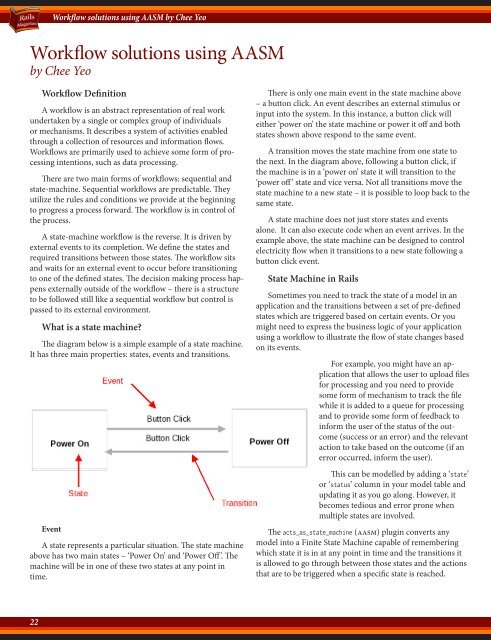Rails Magazine - Issue 3
Rails Magazine - Issue 3
Rails Magazine - Issue 3
You also want an ePaper? Increase the reach of your titles
YUMPU automatically turns print PDFs into web optimized ePapers that Google loves.
22<br />
22<br />
Workflow Definition<br />
A workflow is an abstract representation of real work<br />
undertaken by a single or complex group of individuals<br />
or mechanisms. It describes a system of activities enabled<br />
through a collection of resources and information flows.<br />
Workflows are primarily used to achieve some form of processing<br />
intentions, such as data processing.<br />
There are two main forms of workflows: sequential and<br />
state-machine. Sequential workflows are predictable. They<br />
utilize the rules and conditions we provide at the beginning<br />
to progress a process forward. The workflow is in control of<br />
the process.<br />
A state-machine workflow is the reverse. It is driven by<br />
external events to its completion. We define the states and<br />
required transitions between those states. The workflow sits<br />
and waits for an external event to occur before transitioning<br />
to one of the defined states. The decision making process happens<br />
externally outside of the workflow – there is a structure<br />
to be followed still like a sequential workflow but control is<br />
passed to its external environment.<br />
What is a state machine?<br />
The diagram below is a simple example of a state machine.<br />
It has three main properties: states, events and transitions.<br />
Event<br />
Workflow solutions using AASM by Chee Yeo<br />
Workflow solutions using AASM<br />
by Chee Yeo<br />
A state represents a particular situation. The state machine<br />
above has two main states – ‘Power On’ and ‘Power Off ’. The<br />
machine will be in one of these two states at any point in<br />
time.<br />
There is only one main event in the state machine above<br />
– a button click. An event describes an external stimulus or<br />
input into the system. In this instance, a button click will<br />
either ‘power on’ the state machine or power it off and both<br />
states shown above respond to the same event.<br />
A transition moves the state machine from one state to<br />
the next. In the diagram above, following a button click, if<br />
the machine is in a ‘power on’ state it will transition to the<br />
‘power off ’ state and vice versa. Not all transitions move the<br />
state machine to a new state – it is possible to loop back to the<br />
same state.<br />
A state machine does not just store states and events<br />
alone. It can also execute code when an event arrives. In the<br />
example above, the state machine can be designed to control<br />
electricity flow when it transitions to a new state following a<br />
button click event.<br />
State Machine in <strong>Rails</strong><br />
Sometimes you need to track the state of a model in an<br />
application and the transitions between a set of pre-defined<br />
states which are triggered based on certain events. Or you<br />
might need to express the business logic of your application<br />
using a workflow to illustrate the flow of state changes based<br />
on its events.<br />
For example, you might have an application<br />
that allows the user to upload files<br />
for processing and you need to provide<br />
some form of mechanism to track the file<br />
while it is added to a queue for processing<br />
and to provide some form of feedback to<br />
inform the user of the status of the outcome<br />
(success or an error) and the relevant<br />
action to take based on the outcome (if an<br />
error occurred, inform the user).<br />
This can be modelled by adding a ‘state’<br />
or ‘status’ column in your model table and<br />
updating it as you go along. However, it<br />
becomes tedious and error prone when<br />
multiple states are involved.<br />
The acts_as_state_machine (AASM) plugin converts any<br />
model into a Finite State Machine capable of remembering<br />
which state it is in at any point in time and the transitions it<br />
is allowed to go through between those states and the actions<br />
that are to be triggered when a specific state is reached.


